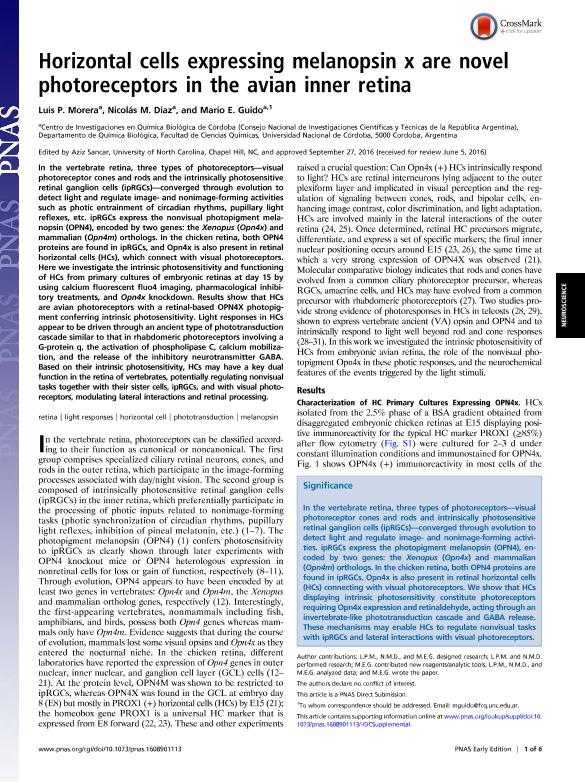Artículo
Horizontal cells expressing melanopsin x are novel photoreceptors in the avian inner retina
Fecha de publicación:
11/2016
Editorial:
National Academy of Sciences
Revista:
Proceedings of the National Academy of Sciences of The United States of America
ISSN:
0027-8424
e-ISSN:
1091-6490
Idioma:
Inglés
Tipo de recurso:
Artículo publicado
Clasificación temática:
Resumen
In the vertebrate retina, three types of photoreceptors - visual photoreceptor cones and rods and the intrinsically photosensitive retinal ganglion cells (ipRGCs) - converged through evolution to detect light and regulate image- and nonimage-forming activities such as photic entrainment of circadian rhythms, pupillary light reflexes, etc. ipRGCs express the nonvisual photopigment melanopsin (OPN4), encoded by two genes: the Xenopus (Opn4x) and mammalian (Opn4m) orthologs. In the chicken retina, both OPN4 proteins are found in ipRGCs, and Opn4x is also present in retinal horizontal cells (HCs), which connect with visual photoreceptors. Here we investigate the intrinsic photosensitivity and functioning of HCs from primary cultures of embryonic retinas at day 15 by using calcium fluorescent fluo4 imaging, pharmacological inhibitory treatments, and Opn4x knockdown. Results show that HCs are avian photoreceptors with a retinal-based OPN4X photopigment conferring intrinsic photosensitivity. Light responses in HCs appear to be driven through an ancient type of phototransduction cascade similar to that in rhabdomeric photoreceptors involving a G-protein q, the activation of phospholipase C, calcium mobilization, and the release of the inhibitory neurotransmitter GABA. Based on their intrinsic photosensitivity, HCs may have a key dual function in the retina of vertebrates, potentially regulating nonvisual tasks together with their sister cells, ipRGCs, and with visual photoreceptors, modulating lateral interactions and retinal processing.
Palabras clave:
Horizontal Cell
,
Light Responses
,
Melanopsin
,
Phototransduction
,
Retina
Archivos asociados
Licencia
Identificadores
Colecciones
Articulos(CIQUIBIC)
Articulos de CENTRO DE INVEST.EN QCA.BIOL.DE CORDOBA (P)
Articulos de CENTRO DE INVEST.EN QCA.BIOL.DE CORDOBA (P)
Citación
Morera, Luis Pedro; Díaz, Nicolás Maximiliano; Guido, Mario Eduardo; Horizontal cells expressing melanopsin x are novel photoreceptors in the avian inner retina; National Academy of Sciences; Proceedings of the National Academy of Sciences of The United States of America; 113; 46; 11-2016; 13215-13220
Compartir
Altmétricas




